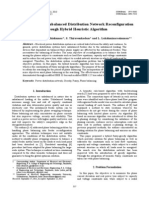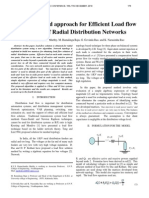Capacitor Placement
Capacitor Placement
Uploaded by
mallagouthamCopyright:
Available Formats
Capacitor Placement
Capacitor Placement
Uploaded by
mallagouthamOriginal Title
Copyright
Available Formats
Share this document
Did you find this document useful?
Is this content inappropriate?
Copyright:
Available Formats
Capacitor Placement
Capacitor Placement
Uploaded by
mallagouthamCopyright:
Available Formats
16th NATIONAL POWER SYSTEMS CONFERENCE, 15th-17th DECEMBER, 2010
26
Comparison of Loss Sensitivity Factor & Index Vector methods in Determining Optimal Capacitor Locations in Agricultural Distribution
K.V.S. Ramachandra Murthy, M. Ramalinga Raju, G. Govinda Rao, K. Narasimha Rao
Abstract : Utilization of fixed capacitors is one of the most important methods in loss reduction and improving the voltage profile of distribution systems. In this paper, suitable capacitor locations are obtained based on index vector method and loss sensitivity factor method. Both the methods are based on power loss. The correctness of the locations is checked by obtaining optimal sizes of capacitors. Optimal sizes of the fixed capacitors are given by Index Vector method and particle swarm optimization method respectively. The distribution networks with balanced loading and radial configuration is considered for analysis. Finally, these methods are tested on a region of the distribution network of the Andhra Pradesh Eastern Power Distribution Corporation consisting of 22 buses. It is observed that Loss sensitivity factor method is more effective.
In this paper, the objective is to find the optimal location for keeping fixed capacitors in distribution networks by using index vector, Loss sensitivity factor methods. Particle swarm optimization method is used to obtain the size of capacitor units in the locations given by loss sensitivity factor method. II. DISTRIBUTION LOAD FLOW EQUATIONS
V11 R + jX V22
P 2 + jX2
I.
INTRODUCTION P2 and Q2 are effective active and reactive powers supplied beyond node 2. Formulae have been derived in [8]. The simple and efficient method of load flow was developped by Das and Kothari.
One of the most effective and useful methods in reducing the power losses in distribution networks is utilization of optimal capacitor placement. Capacitors are installed in distribution systems for reactive power compensation. The Capacitor placement problem is the process of determination of the location, size and number of the capacitor to be placed in a radial distribution system. The objectives are to reduce the losses in the system and to maintain good voltage profile within the limits. Various techniques have been implemented by researchers for optimal capacitor placement problem. Integer programming method was used by Wang J. et. al. [1]. Nonlinear programming method was implemented in [2, 3], Sensitivity analysis method is used by Huang [4], Gallego et. al. [5], The equal area criterion for selecting the sites of fixed capacitors was used by Grainger [6], Delfanti used dynamic programming method [7] for solving the capacitor placement problem. Simple and Efficient method of distribution load flow was developed by D.Das et. al [8]. Topology based approach was introduced by J. H. Teng [9]. Index Vector method was used by Sydulu et. al in [10]. Loss Sensitivity factors were obtained for obtaining optimal capacitor locations and Particle Swarm Optimization was used for obtaining optimal sizes of capacitors in [11].
K.V.S. Ramachandra Murthy is working as Associate Professor, College of Engineering., Visakhapatnam. Mail: murthykvs2000@yahoo.co.in G.V.P.
(1)
(2)
(3)
(4) (5) III. INDEX VECTOR METHOD FOR OPTIMAL CAPACITOR PLACEMENT 1. Objective Function The Objective function in the capacitor placement problem comprises of the minimization of the total real power losses in the given Radial Distribution System. The Objective function is given by:
M. Ramalinga Raju is Professor and Head of the Department of E.E.E. at University college of Engineering, JNTU, Kakinada, India. Mail : rajumanyala@rediffmail.com G.Govinda Rao and K. Narasimha Rao are working as Professor, G.V.P. College of Engineering., Visakhapatnam.
(6)
Department of Electrical Engineering, Univ. College of Engg., Osmania University, Hyderabad, A.P, INDIA.
16th NATIONAL POWER SYSTEMS CONFERENCE, 15th-17th DECEMBER, 2010
27
where P[k], Q[k] =Real and reactive power in the Branch k V[n] =Voltage at node n R[k] =Resistance of the branch k 2. Index Vector Based Method Loss sensitivity factors,
(9)
are calculated using load
Index Vector based method is the conventional approach for optimal capacitor placement[22]. Index Vector is formulated by running the base case load flow on a given radial distribution network, and calculating reactive component of current in the branches and reactive power load concentration at each node. Based on the elements of the Index Vector, this method identifies a sequence of nodes to be compensated. The sequence of priority of the nodes is mainly determined by the Index-Vector. The Index-Vector for bus n is given by
flow, and values are arranged in descending order for all the lines. Normalized voltage magnitudes are calculated for all the buses. by the following formula.
(10)
Buses, whose normalized values are less than 1.01 are considered as candidate nodes requiring compensation. Loss Sensitivity factors decide the sequence of in which buses are to be considered for compensation placement and the normalized values of voltages decide, whether a particular bus needs compensation or not. V. PARTICLE SWARM OPTIMIZATION
(7)
where Index[n] =Index for nth bus V[n] = Voltage at nth bus Iq[k] = Imaginary component of current in kth branch Ip[k] = Real component of current in kth branch Qeff[n] = Effective load at nth bus TotalQ = Total reactive load of the given Distribution system After formulating the Index Vector multiply the index value by the load reactive power at that bus to estimate the size of the capacitor to be placed. Thus, the potential location and size of the capacitor to be placed are obtained directly. Arrange the Index vector in descending order so that highest priority bus will come first and the lowest priority bus will come at end. Now place the capacitor at the first potential location and run the load flow and estimate the losses .Then assume capacitors at first two potential locations and perform load flow again evaluate the corresponding losses. It may be observed that the loss will reduce. Repeat this with estimated capacitors at first n busses till losses reduce to minimum and for the first (n+1) potential locations the loss start increasing Then the estimated capacitors at first n potential locations will give optimal location and size for the given radial distribution system. IV. SENSITIVITY ANALYSIS Loss sensitivity factors are calculated for determining the candidate nodes for placement of capacitors. Estimation of these sensitive nodes helps in reducing the search space.
Particle swarm optimization (PSO) is a population based stochastic optimization technique developed by Dr. Eberhart and Dr. Kennedy in 1995. This method is based on the social behavior of bird flocking or fish schooling . PSO has many similarities with evolutionary computation techniques like Genetic Algorithms (GA). The system is initialized with a population of random solutions and searches for optimal solution by updating generations in different iterations. However, unlike GA, PSO has no evolution operators such as crossover and mutation. In every iteration, each particle is updated by following two "best" values. The first one is the best solution (fitness) it has achieved so far. This value is called pbest. Another "best" value that is tracked by the particle swarm optimizer is the best value, obtained so far by any particle in the population. This best value is a global best and called gbest. Velocity Updation: ith particle velocity is updated by the eqn, v[i][j] =K*(w* v[i][j]+ c1*rand( )*( pbestx[i][j] - x[i][j] ) + c2*rand( )*( gbestx[i][j] - x[i][j] ) ) (11) x[i][j] = x[i][j] + v[i][j] Equation for updating the position of the particle : K is called constriction factor = 0.7259 c1, c2 weight factors= 2.05 w inertia weight parameter=1.2 i particle number, j control variable. There are eight capacitors required. In each row, six capacitor values are assumed. Particle[i] = [ q1 q2 q3 q4 q5 q6 q7 q78] Initially 20 particles are randomly selected. Velocities are also randomly selected and then updated by the given formulae. Capmin, minimum capacitor rating = 0 kvar and
(8)
Department of Electrical Engineering, Univ. College of Engg., Osmania University, Hyderabad, A.P, INDIA.
16th NATIONAL POWER SYSTEMS CONFERENCE, 15th-17th DECEMBER, 2010
28
Capmax, maximum capacitor rating = 150 kvar is assumed. Vmax = (Capmax Capmin)/n. (12)
If the velocity violates the limits (-vmax, vmax), it is set to the limit it violates. Particle position is updated by adding velocity to it. Iterations are continued till 6 iterations. The techniques discussed were applied for the part of the network of APEPDCL, which is modeled as a 22 bus system. Data of the feeder is presented in Table I. Load data is given in Table II.
TABLE I SYSTEM DATA OF THE FEEDER Line No. 1 2 3 4 5 6 7 8 9 10 11 12 13 14 15 16 17 18 19 20 21 From Bus 1 2 2 4 4 5 6 6 9 9 11 11 13 14 14 16 17 17 19 20 20 To Bus 2 3 4 5 9 6 7 8 10 11 12 13 14 15 16 17 18 19 20 21 22 Resistance (ohm) 0.3664 0.0547 0.5416 0.193 0.7431 1.3110 0.0598 0.2905 0.0547 0.675 0.0547 0.3942 1.0460 0.022 0.0547 0.3212 0.0949 0.574 0.1292 0.0871 0.5329 Reactance (ohm) 0.1807 0.0282 0.2789 0.099 0.3827 0.6752
with the sizes of capacitors given by PSO. It is interesting to note that the locations given by the two methods are not same. They differ because of the different mathematical formulations. LSF method gives priority nodes based on the rate of change of real power loss with respect to reactive power consumed at that node. Index Vector method determines the priority nodes based on the three components discussed in Section III.
TABLE II LOAD DATA OF THE FEEDER Bus No. 1 2 3 4 5 6 7 8 9 10 Real Power(Kw) 0 16.78 16.78 33.80 14.56 19.31 10.49 8.821 14.35 14.35 16.27 16.27 82.13 34.71 34.71 80.31 49.62 49.62 43.77 37.32 37.32 31.02 Reactive Power(Kvar) 0 20.91 20.91 37.32 12.52 25.87 14.21 11.66 18.59 18.59 19.48 19.48 71.65 30.12 30.12 70.12 47.82 47.82 38.93 35.96 35.96 29.36
0.0308 11 0.1496 0.0282 0.3481 0.0282 0.203 0.5388 0.0116 0.0282 20 0.1654 0.0488 0.2959 0.066 0.045 0.2744 21 22 12 13 14 15 16 17 18 19
VI. RESULTS Optimal capacitor locations and sizes given by index vector method are presented in Table III. Optimal capacitor locations given by sensitivity analysis given in Table IV along
Voltage magnitudes and angles are compared before and after compensation using index vector method are presented in Table V. Angle values are positive before compensation and they are found to be negative after compensation. Voltage magnitude without compensation, with compensation using Index Vector method and with PSO are presented in VII. . The results are promising. They are almost very nearer to each other and in acceptable voltage limits. Comparison of real and reactive power loss before and after placement of capacitors between Index-Vector method and Loss sensitivity factor method is presented in table VI.
Department of Electrical Engineering, Univ. College of Engg., Osmania University, Hyderabad, A.P, INDIA.
16th NATIONAL POWER SYSTEMS CONFERENCE, 15th-17th DECEMBER, 2010
29
TABLE III OPTIMAL LOCATION AND CAPACITOR SIZE GIVEN BY INDEX VECTOR METHOD Optimal Location ( Bus No) given by Index Vector method 13 16 4 17 18 19 14 6 TOTAL Optimal Capacitor sizes (kVAr) given by Index Vector method 137.71 120.90 79.58 76.99 63.03 57.43 54.80 51.85 642.29
TABLE. V COMPARISON OF VOLTAGES AND ANGLES WITH AND WITHOUT COMPENSATION BY INDEX VECTOR METHOD Bus No 1 2 3 4 5 6 7 8 9 10 11 12 13 14 15 16 17 18 19 20 21 22 Voltage p.u without compensation 1 0.9969 0.9969 0.9926 0.9925 0.9918 0.9917 0.9917 0.9875 0.9875 0.9832 0.9832 0.9808 0.9756 0.9756 0.9754 0.9744 0.9743 0.9733 0.9731 0.9731 0.9729 Voltage p.u with compensation 1 0.9979 0.9979 0.9951 0.995 0.9946 0.9946 0.9946 0.9917 0.9917 0.9889 0.9889 0.9874 0.984 0.984 0.9838 0.9831 0.9831 0.9822 0.982 0.982 0.9818 Voltage angles Before After compensation compensation 0 0 0.0572 - 0.0515 0.0572 - 0.0515 0.1317 - 0.1432 0.1375 - 0.1432 0.1546 - 0.1604 0.1546 - 0.1604 0.1604 - 0.1604 0.2177 - 0.2406 0.2177 - 0.2406 0.2864 - 0.3380 0.2864 0.3265 0.4067 0.4067 0.4125 0.4297 0.4297 0.4469 0.4526 0.4526 0.4526 - 0.3380 - 0.4010 - 0.5099 - 0.5099 - 0.5156 - 0.5271 - 0.5328 - 0.5271 - 0.5213 - 0.5213 - 0.5213
TABLE IV OPTIMAL LOCATION GIVEN BY LOSS SENSITIVITY FACTOR METHOD AND CAPACITOR SIZES GIVEN BY PSO Optimal Location ( Bus No.) given by Loss Sensitivity Factor method
14
Optimal Capacitor sizes (kVAr) given by P.S.O.
136.63
9 4 11 2 13 19 17 Total KVAR
25.34 104.67 58.39 10.89 79.25 100.67 110.84
TABLE VI COMPARISION OF LOSSES Total loss before placement of capacitors Total loss after placement of Capacitors using index vector method 9.22 4.72 Total loss using Loss sensitivity Factor method 9.22 4.72
Loss 626.68 Real Power Loss (KW) Reactive Power Loss(Kvar) Total real power loss reduction(KW) Total reactive power loss rduction(KVAR)
VII. CONCLUSIONS Optimal location and size for capacitors is given by index method in the first case. In the second case, locations are given by loss sensitivity factor method and size of the capacitor is given by particle swarm optimization method. The sizes of capacitors, voltages, and power losses are compared. The results are very promising. In the second case, loss reduction is same but, the amount of reactive power requirement is less than the first method. Though the voltages obtained in the second case (LSF and PSO) method are slightly lower, they are in acceptable limits and reasonably good. It is interesting to find that the locations are not same given by two methods and the sizes are also different in both the methods. But, total reactive power used for compensation is almost nearer to each other. Q compensation is equal to 642.29 kVAr in the Index Vector method and 626.68 kVAr in the second case. The maximum reduction in active and reactive power loss is also same for the given system.
17.69 9.05
8.47
8.47
4.33
4.33
REFERENCES
[1] WANG, J., CHIANG, H., NAN MINU, K., DARLING, G., Capacitor Placement and Real Time Control in Large-Scale Un- balanced Distribution Systems: Part I & II, IEEE Trans. On Power Delivery 12 ,1997, 953964. [2] CARPINELLI, G., VARILONE, P, Di VITO, V., ABUR, A. : Capacitor Placement in Three-phase Distribution Systems with Nonlinear and Unbalanced Loads, IEE Proc.-Gener. Trans. Distrib, 152 No. 1, 2005, pp. 4752. [3] CHIANG, H., WANG, J., DARLING, G. Optimal Capacitor Placement, Replacement and Control in Large-Scale Unbalanced Distribution Systems: Part I & II, IEEE Trans. On Power Systems 10 , 1995, pp. 356369.
Department of Electrical Engineering, Univ. College of Engg., Osmania University, Hyderabad, A.P, INDIA.
16th NATIONAL POWER SYSTEMS CONFERENCE, 15th-17th DECEMBER, 2010
30
TABLE VII COMPARISON OF VOLTAGE MAGNITUDES Voltage p.u with compensation using index vector method 1 0.9979 0.9979
0.9951
Bus No
Voltage p.u without compensation
Voltages with compensation using Loss sensitivity factor method and PSO 1 0.9979 0.9979 0.995
1 2 3 4 5 6 7 8 9 10 11 12 13 14 15 16 17 18 19 20 21 22
1 0.9969 0.9969
0.9926
[8] D. Das, D.P. Kothari, A Kalam Simple and effcient method for load flow Solution of radial distribution networks., Journal of Electrical Power and Energy Systems, Vol 17, No.5, pp335 346,1995. [9] Jen-Hao Teng, A Network- Topology based Three-Phase Load flow for Distribution systems, Proceedings of the National Science Council, ROC(A), Vol.24, No.4, 2000, Pp. 259-264. [10] V.V. K. Reddy and M. Sydulu, Index and GA based Optimal Location and Sizing of Distribution System Capacitors, Power Engineering Society General Meeting, June, 2007, Tampa, FL, pp1-4. [11] K. Prakash, M. Sydulu, Particle Swarm Optimization Based Capacitor Placement on Radial Distribution Systems, Power Engineering Society General Meeting, June, 2007, Tampa, FL, pp1-4. BIOGRAPHIES
0.9925 0.9918 0.9917 0.9917 0.9875 0.9875 0.9832 0.9832 0.9808 0.9756 0.9756
0.9754
0.995 0.9946 0.9946 0.9946 0.9917 0.9917 0.9889 0.9889 0.9874 0.984 0.984
0.9838
0.9949 0.9942 0.9942 0.9942 0.9916 0.9916 0.9888 0.9887 0.9871 0.9836 0.9835 0.9834 0.9827 0.9826 0.9819 0.9817 0.9816 0.9815 K. V. S .Ramachandra Murthy did his graduation in Electrical Engineering and M. Tech in Power Systems from R.I.T., Jamshedpur in 1994 and 2002 respectively. He is pursuing his Ph.D. from J.N.T.U., Hyderabad, India. He had four years of industrial experience and eight years of Teaching Experience. He is currently employed as Associate Professor in Electrical Engineering Department in G. V. P. College of Engineering, Visakhapatnam, India. His research interests are in the Management of Electrical Energy. M. Ramalinga Raju did his B. Tech in Electrical Engineering from J.N.T.U. College of Engineering, Kakinada in 1986 and M. Tech in Electrical Machines and Industrial Drives from Regional Engineering College, Warangal, India in 1989. He did his Ph.D. from J.N.T.U., Hyderabad, India in the year 2004. Presently he is Professor & Head ' Department of Electrical and Electronics Engineering, University College of Engineering, Kakinada ,JNTU Kakinada, India. His areas of interest are Energy Management, Power Electronics. G. Govinda Rao was born in Srikakulam, Andhra Pradesh, India on January 19th, 1939. He graduated in Electrical Engineering from the College of Engineering, Kakinada, affiliated to Andhra University in 1959. He obtained his M.E. Degree from Andhra University in 1966 and Ph.D. from I.I.Sc, Bangalore in 1981. He had his teaching career at Andhra University college of Engineering for four decades and is currently employed in Gayatri Vidya Parishad College of Engineering, Visakhapatnam, India. Govinda Rao received the Best Teacher Award from the A.P. State Govt. in 1996 and is a Felllow of Institute of Engineers, India and a Member of the Indian Society of Technical Education. His research interests are in the areas of Fundamentals of Circuit Analysis and Power System Analysis and Stability. K. Narasimha Rao has obtained degree in Electrical Engineering from the Institute of Engineers (INDIA), Kolkata in summer 1996 and Post Graduation M. Tech. in IT Power Engineering from Jawaharlal Nehru Technological University, Hyderabad in December, 2002 and Ph. D. from JNT University, Hyderabad, India in the year 2009. He is having 14 years of experience in teaching and presently working as Professor with GVP College of Engineering, Visakhapatnam, AP, India. He is a Life member of ISTE, New Delhi and Member of Institute of Engineers (India), Kolkata. His research of interests includes Power System Security, Application of Neural Networks & Fuzzy in power system.
0.9744
0.9743
0.9831
0.9831
0.9733 0.9731
0.9731
0.9822 0.982
0.982
0.9729
0.9818
[4] HUANG, Y. C.YANG, H. T.HUANG, C. L. : Solving the Capacitor Placement Problem in a Radial Distribution System Using Tabu Search Application, IEEE Trans. On Power Systems 11 (1996), 1868 1873. [5] GALLEGO, R. A., MONTICELLI, A. J., ROMERO, R. : Optimal Capacitor Placement in Radial Distribution Networks, IEEE Trans. On Power Systems 16 (2001), 630637. [6] GRAINGER, J. J. LEE, S. H., Optimum Size and Location of Shunt Capacitors for Reduction of Losses on Distribution Feeders, IEEE Trans. On Power Appar. A. Syst., PAS-100, 1981, pp. 11051118. [7] DLFANTI, M.GRANELLI, G. P.MARANNINIO, P. : Optimal Capacitor Placement Using Deterministic and Genetic Algorithm, IEEE Trans. On Power Systems 15 (2000), 10411046.
Department of Electrical Engineering, Univ. College of Engg., Osmania University, Hyderabad, A.P, INDIA.
You might also like
- 6.1. Concept of Power FactorDocument10 pages6.1. Concept of Power FactormahaprabuasNo ratings yet
- 02 ETR300-R-600 Manual ControlDocument470 pages02 ETR300-R-600 Manual ControlPedro ZuñigaNo ratings yet
- An Efficient Approach For Capacitor Sizing and Location On A Radial Distribution System Using Artificial Intelligence TechniqueDocument5 pagesAn Efficient Approach For Capacitor Sizing and Location On A Radial Distribution System Using Artificial Intelligence Techniquesahastra244122No ratings yet
- Optimal Capacitor Placement in A Radial Distribution System Using Dijkstra AlgorithmDocument9 pagesOptimal Capacitor Placement in A Radial Distribution System Using Dijkstra AlgorithmDizky Christian HadiNo ratings yet
- Optimal Capacitor Allocation For Minimizing Cost of Energy Loss in Active Distribution Network With Different Load LevelsDocument12 pagesOptimal Capacitor Allocation For Minimizing Cost of Energy Loss in Active Distribution Network With Different Load LevelsInternational Journal of Applied Power EngineeringNo ratings yet
- 19 Avadhanam Kartikeya Sarma Final PaperDocument11 pages19 Avadhanam Kartikeya Sarma Final PaperiisteNo ratings yet
- IET Template PDFDocument9 pagesIET Template PDFdebasishmee5808No ratings yet
- Ijeet: International Journal of Electrical Engineering & Technology (Ijeet)Document9 pagesIjeet: International Journal of Electrical Engineering & Technology (Ijeet)IAEME PublicationNo ratings yet
- Dijkstra Algorithm For Feeder Routing of Radial Distribution SystemDocument6 pagesDijkstra Algorithm For Feeder Routing of Radial Distribution SystemIOSRJEN : hard copy, certificates, Call for Papers 2013, publishing of journalNo ratings yet
- Multi-Objective Unbalanced Distribution Network Reconfiguration Through Hybrid Heuristic AlgorithmDocument8 pagesMulti-Objective Unbalanced Distribution Network Reconfiguration Through Hybrid Heuristic AlgorithmbaalaajeeNo ratings yet
- Optimal Capacitor Placement and Sizing in Unbalanced Distribution Systems With Harmonics Consideration Using Particle Swarm OptimizationDocument8 pagesOptimal Capacitor Placement and Sizing in Unbalanced Distribution Systems With Harmonics Consideration Using Particle Swarm OptimizationMohammad HosseiniNo ratings yet
- Optimal Sizing of Capacitors Placed On A Radial Distribution SystemDocument9 pagesOptimal Sizing of Capacitors Placed On A Radial Distribution SystemghotourNo ratings yet
- Sizing of Capacitors Placed Ieee 735 PDFDocument9 pagesSizing of Capacitors Placed Ieee 735 PDFEnrique Anchundia GuerreroNo ratings yet
- Optimal Capacitor Placement in Distribution Networks Regarding Uncertainty in Active Power Load and Distributed Generation Units ProductionDocument8 pagesOptimal Capacitor Placement in Distribution Networks Regarding Uncertainty in Active Power Load and Distributed Generation Units ProductionApikShafieeNo ratings yet
- Optimal Placement of Capacitors in Radial Distribution System To Minimizes The Losses at Variable Load LevelsDocument4 pagesOptimal Placement of Capacitors in Radial Distribution System To Minimizes The Losses at Variable Load LevelsEditor IJRITCCNo ratings yet
- 11 IjsrmDocument7 pages11 Ijsrmswapna44No ratings yet
- Optimal Selection of Capacitors For Radial Distribution Systems Using Plant Growth Simulation AlgoriDocument13 pagesOptimal Selection of Capacitors For Radial Distribution Systems Using Plant Growth Simulation AlgoriEverton Klinger Sousa SilvaNo ratings yet
- A New Efficient Method For Load-Flow Solution For Radial Distribution NetworksDocument8 pagesA New Efficient Method For Load-Flow Solution For Radial Distribution NetworksjorgiieNo ratings yet
- Literature Survey For Compensating Capacitor PlacementDocument8 pagesLiterature Survey For Compensating Capacitor Placementhodeegits9526No ratings yet
- E 021052327Document5 pagesE 021052327IOSRJEN : hard copy, certificates, Call for Papers 2013, publishing of journalNo ratings yet
- Abstract - : The Energy Usage IsDocument5 pagesAbstract - : The Energy Usage IsNunna BaskarNo ratings yet
- Capacitor Placement For Loss Reduction in Radial Distribution Networks: A Two Stage ApproachDocument6 pagesCapacitor Placement For Loss Reduction in Radial Distribution Networks: A Two Stage ApproachmohancrescentNo ratings yet
- Optimal Capacitor Configuration For Enhancement of System Reliability Using Genetic Algorithm: A Case Study of IEEE 30 Bus SystemDocument5 pagesOptimal Capacitor Configuration For Enhancement of System Reliability Using Genetic Algorithm: A Case Study of IEEE 30 Bus SystemIDESNo ratings yet
- Capicitor PlacementDocument5 pagesCapicitor PlacementSharad PatelNo ratings yet
- Optimal Allocation of Capacitors in Radial Distribution Systems With Distributed GenerationDocument6 pagesOptimal Allocation of Capacitors in Radial Distribution Systems With Distributed GenerationJaviForeroNo ratings yet
- Optimal Location and Sizing of Shunt Capacitors in Distribution Systems by Considering Different Load ScenariosDocument9 pagesOptimal Location and Sizing of Shunt Capacitors in Distribution Systems by Considering Different Load ScenariosSudheerKumarNo ratings yet
- Capacitor Placement in Unbalanced Power SystemsDocument6 pagesCapacitor Placement in Unbalanced Power SystemsFabio NobNo ratings yet
- Capacitor Placement in Radial Distribution Systems For Loss ReductionDocument5 pagesCapacitor Placement in Radial Distribution Systems For Loss ReductionhmortNo ratings yet
- Sensitivity Based Capacitor Placement With Self-Adaptive Differential Evolution With Neighborhood Search AlgorithmDocument5 pagesSensitivity Based Capacitor Placement With Self-Adaptive Differential Evolution With Neighborhood Search AlgorithmDinakara Prasad ReddyNo ratings yet
- Optimal Capacitor Placement For IEEE 14 Bus System Using Genetic AlgorithmDocument11 pagesOptimal Capacitor Placement For IEEE 14 Bus System Using Genetic AlgorithmAkinbode Sunday OluwagbengaNo ratings yet
- Reconfiguration and Capacitor Placement For Loss Reduction of Distribution Systems by Ant Colony Search AlgorithmDocument9 pagesReconfiguration and Capacitor Placement For Loss Reduction of Distribution Systems by Ant Colony Search AlgorithmthanatitosNo ratings yet
- 7054Document4 pages7054amirhbarekatiNo ratings yet
- Maximizing Power System Loadability by Optimal Allocation of SVC Using Mixed Integer Linear ProgrammingDocument7 pagesMaximizing Power System Loadability by Optimal Allocation of SVC Using Mixed Integer Linear ProgrammingMohamed MansourNo ratings yet
- 2019 - Analytical Method For Optimal Reactive Power Support in Power NetworkDocument6 pages2019 - Analytical Method For Optimal Reactive Power Support in Power NetworkMohsin ShahzadNo ratings yet
- Optimal Conductor Selection Distribution Systems Evolutionary StrategiesDocument5 pagesOptimal Conductor Selection Distribution Systems Evolutionary StrategiesAmit SinghNo ratings yet
- Loss ReductionDocument35 pagesLoss Reductionsolomon nchor akansakeNo ratings yet
- Optimal Location and Sizing of Shunt CapDocument9 pagesOptimal Location and Sizing of Shunt CapDa VidNo ratings yet
- Page 8 Report7Document39 pagesPage 8 Report7Akshay NaikNo ratings yet
- Habsi 19Vol58No2Document8 pagesHabsi 19Vol58No2NurAfandiAlhabsiNo ratings yet
- Mah Davian 2017Document4 pagesMah Davian 2017Pradeep PeriasamiNo ratings yet
- 012078085FDocument8 pages012078085Fchetan2042No ratings yet
- Utilization of Trust Region Algorithm in Solving Reactive Power Compensation ProblemDocument19 pagesUtilization of Trust Region Algorithm in Solving Reactive Power Compensation ProblemscheilabiehlNo ratings yet
- Voltage Profile Improvement by Capacitor Placement and Control in Unbalanced Distribution Systems Using Differential Evolution AlgorithmDocument8 pagesVoltage Profile Improvement by Capacitor Placement and Control in Unbalanced Distribution Systems Using Differential Evolution Algorithmswapna44No ratings yet
- Optimal Placement of Capacitor For Voltage Support and Minimizing Overall Cost in Radial Distribution SystemDocument5 pagesOptimal Placement of Capacitor For Voltage Support and Minimizing Overall Cost in Radial Distribution SystemDavid Omar Torres GutierrezNo ratings yet
- CIRED2009 0518 PaperDocument4 pagesCIRED2009 0518 PapersrivaishnaviNo ratings yet
- A Fast Approach Distribution System Load Flow SolutionDocument11 pagesA Fast Approach Distribution System Load Flow SolutionAlejandroHerreraGurideChileNo ratings yet
- Optimal Multi-Objective Var Planning Using Accelerated Ant Colony and Analytical Hierarchy Process MethodsDocument7 pagesOptimal Multi-Objective Var Planning Using Accelerated Ant Colony and Analytical Hierarchy Process MethodsBalasubramaniNo ratings yet
- Optimal Capacitor Placement For IEEE 14 Bus System Using Genetic AlgorithmDocument11 pagesOptimal Capacitor Placement For IEEE 14 Bus System Using Genetic AlgorithmIJIRAE- International Journal of Innovative Research in Advanced Engineering100% (1)
- A New Hybrid Optimization Method For Optimum Distribution Capacitor PlanningDocument7 pagesA New Hybrid Optimization Method For Optimum Distribution Capacitor PlanningSrikarPolasanapalliNo ratings yet
- 192 New Reactive Power Optimization AlgorithmDocument6 pages192 New Reactive Power Optimization Algorithmlcm3766lNo ratings yet
- 20Document6 pages20Dinesh BabuNo ratings yet
- Artigo CYMDIST2Document26 pagesArtigo CYMDIST2Arthur OliveiraNo ratings yet
- National Institute of Technology: Karnataka, SurathkalDocument36 pagesNational Institute of Technology: Karnataka, SurathkalSneha JogdhankarNo ratings yet
- Cat Swarm Optimization To Shunt Capacitor Allocation in Algerian Radial Distribution Power SystemDocument10 pagesCat Swarm Optimization To Shunt Capacitor Allocation in Algerian Radial Distribution Power SystemIAES IJAINo ratings yet
- (ELD) Problem For Finding The Optimal Combination of The Output PowerDocument45 pages(ELD) Problem For Finding The Optimal Combination of The Output PowerUdayakumar VengatesanNo ratings yet
- An Approach For Power Flow Analysis of Radial Distribution NetworksDocument7 pagesAn Approach For Power Flow Analysis of Radial Distribution NetworksresearchinventyNo ratings yet
- Power System Report Group 14Document16 pagesPower System Report Group 14bingobazinga2No ratings yet
- Application of GA For Optimal Location of FACTS Devices For Steady State Voltage Stability Enhancement of Power SystemDocument7 pagesApplication of GA For Optimal Location of FACTS Devices For Steady State Voltage Stability Enhancement of Power SystemSuryaNo ratings yet
- Newton-Raphson Method For Power Flow Equations in Matlab EnvironmentDocument5 pagesNewton-Raphson Method For Power Flow Equations in Matlab Environmentashikhmd4467No ratings yet
- Etap TutorialDocument6 pagesEtap TutorialMAGNETOxNo ratings yet
- International Journal of Engineering Research and Development (IJERD)Document9 pagesInternational Journal of Engineering Research and Development (IJERD)IJERDNo ratings yet
- Problems Chptrs1 18Document46 pagesProblems Chptrs1 18celeritas81No ratings yet
- 1st Yr SyllabusDocument33 pages1st Yr SyllabuspukkokignoNo ratings yet
- Unit3 - Electrical SystemDocument57 pagesUnit3 - Electrical SystemNethaji BKNo ratings yet
- Capacitive and Inductive Reactive PowerDocument4 pagesCapacitive and Inductive Reactive Powerabdulyunus_amirNo ratings yet
- Theory:: Electrical CircuitsDocument2 pagesTheory:: Electrical Circuitsahmad ahmadNo ratings yet
- 056-054 DSE8x10 in Fixed Export (Base Load)Document4 pages056-054 DSE8x10 in Fixed Export (Base Load)hariana100% (1)
- Alternating QuantitiesDocument16 pagesAlternating QuantitiesRanjith KotojuNo ratings yet
- SVC For Voltage Stabilization and Harmonic Suppression in Rolling MillDocument2 pagesSVC For Voltage Stabilization and Harmonic Suppression in Rolling MilldeciohNo ratings yet
- EEL2026-LabsheetDocument23 pagesEEL2026-LabsheetchandraNo ratings yet
- Easergy P3 Protection Relays - REL52034Document6 pagesEasergy P3 Protection Relays - REL52034kegssalesNo ratings yet
- Jurnal Lutfiyah 190101018 English VersionDocument6 pagesJurnal Lutfiyah 190101018 English Versionyanuar mamiNo ratings yet
- 0b Three Phase IOHDocument28 pages0b Three Phase IOHkhalidNo ratings yet
- User Manual: HGM9510 Genset Parallel (With Genset) UnitDocument65 pagesUser Manual: HGM9510 Genset Parallel (With Genset) Unitnhocti007100% (1)
- 22 yDocument37 pages22 yczds6594No ratings yet
- Psoc Nov 2021Document3 pagesPsoc Nov 2021studyeeeforyourmtherNo ratings yet
- Power Factor CorrectorDocument16 pagesPower Factor CorrectorMichalis AltousNo ratings yet
- 2014.11.23 - Electrical Specifications Combined - Tender SubmissionDocument426 pages2014.11.23 - Electrical Specifications Combined - Tender Submissionfayas100% (1)
- Elite 440: MFM With High Accuracy, Configurability and Easy IntegrationDocument4 pagesElite 440: MFM With High Accuracy, Configurability and Easy IntegrationTeguh WaluyoNo ratings yet
- Of Steady-State Voltage Stability: Determination Limit Using P-Q Curve M.H. Haque C1V4 + (Q2)Document2 pagesOf Steady-State Voltage Stability: Determination Limit Using P-Q Curve M.H. Haque C1V4 + (Q2)Armando MartinezNo ratings yet
- ZMD400 1UserManualDocument320 pagesZMD400 1UserManualQazas100% (1)
- Dissertation PDFDocument105 pagesDissertation PDFbogdanNo ratings yet
- Power Quality and Grid Code Issues in Wind Energy Conversion SystemDocument17 pagesPower Quality and Grid Code Issues in Wind Energy Conversion SystemJevNo ratings yet
- Supplementary Notes For EE-201 (H. Saadat) Power in Single-Phase Ac CircuitsDocument13 pagesSupplementary Notes For EE-201 (H. Saadat) Power in Single-Phase Ac CircuitsAlpian ManurunNo ratings yet
- Hypot III 3700 ManDocument80 pagesHypot III 3700 Mandaniel ortizNo ratings yet
- User Manual: HGM7200/HGM7100 SeriesDocument69 pagesUser Manual: HGM7200/HGM7100 Seriesnhocti007No ratings yet
- Static Synchronous Compensators STATCOMDocument4 pagesStatic Synchronous Compensators STATCOMrajfab100% (1)
- Research On Inverter Integrated Reactive Power Control Strategy in The Grid-Connected PV SystemsDocument22 pagesResearch On Inverter Integrated Reactive Power Control Strategy in The Grid-Connected PV SystemsBalu MNo ratings yet
- Single Phase AC Circuits NotesDocument164 pagesSingle Phase AC Circuits NotesAdarsh PriyaranjanNo ratings yet

























































































